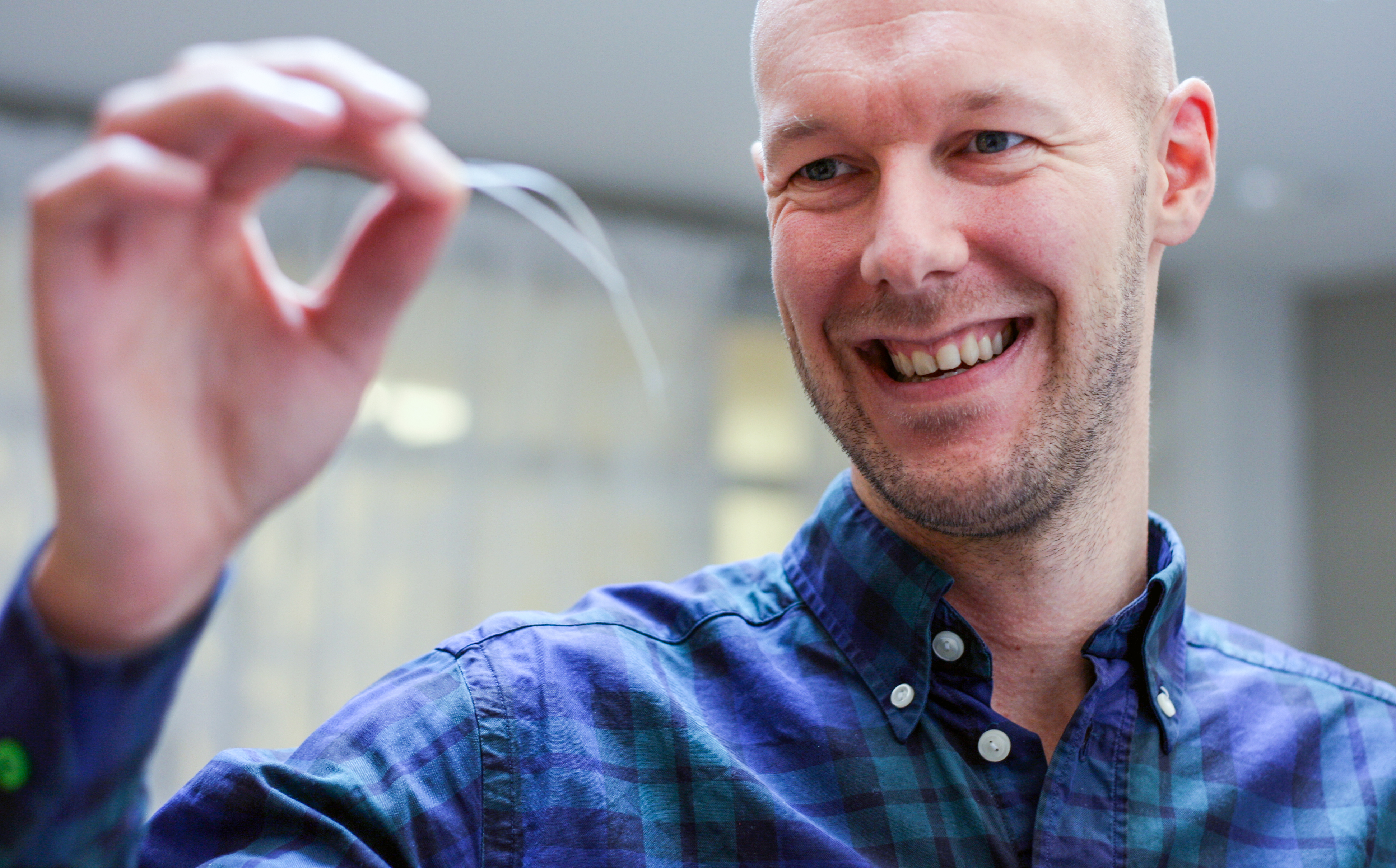| |
 · www.tappi.org
· www.tappi.org
· Subscribe
to Ahead of the Curve
· Newsletters
· Ahead
of the Curve archived issues
· Contact
the Editor

|
|
|
|
Threads of Nanocellulose Stronger Than Spider Silk
"Who would win in a fight between Spiderman and Groot?"

RISE Researcher Karl Håkansson discussing his groundbreaking work in nanocellulose fibrils.
That's the opening query of a presentation by Karl Håkansson, a scientist at the Swedish research organization RISE. According to an article in the recent RISE Newsletter, Håkansson has earned RISE the European Award Blue Sky Young Researchers Innovation Award for its pioneering research into how nanocellulose can answer this engaging question.
Spider silk has been regarded as the world's strongest biomaterial; but thanks to Håkansson's research, today there is something even stronger, the newsletter article reports: A thin thread of spun nanocellulose that could be used for anything from aircraft wings to artificial tendons in the body.
At a ceremony in conjunction with CEPI's recent Paper & Beyond 2018 conference in Brussels, three winners were awarded and selected for the global final of the Blue Sky Young Researchers Innovation Award in Canada in 2019. Håkansson won the jury's appreciation with his presentation of nanotechnology in a macroscopic context.
"Who would win in a fight between Spiderman and Groot?" he asks in his presentation. "As a scientist I like quantifying things. What can be quantified in order to judge this fight? Let's start with Spiderman. His superpower is spider silk, known to be a high-performing material. What about Groot? He is super strong and, as we all know, it is cellullose that is responsible for the mechanical properties in all plants. If only we could have a macroscopic filament consisting of only cellulose to be able to compare it with spider silk! What a coincidence... that is exactly what my invention is. I have spent the last 7-8 years developing a process for the production of cellulose-based filaments."
How it Works
Håkansson—together with colleagues at RISE and KTH Royal Institute of Technology in Stockholm, where Håkansson earned his PhD—has developed a new method of spinning nanocellulose into a thin and strong thread. What gives the thread its strength is that the fibrils in the wood fiber are arranged in the same direction. The idea behind the now patented method involves converting a fiber suspension into gel which, in a water flow, becomes a long, thin thread of nanofibrils.
Measurements performed at the Petra III synchrotron plant showed that the material is actually both stronger and more than eight times stiffer than spider silk, which was previously considered to be the strongest biomaterial.
"The results are obviously spectacular, but what's really exciting is that we now have a material with nano properties that can be applied in macro format for the first time," says Håkansson.
Possible applications range from high-performance medical materials that are not rejected by the body to bio-based, lightweight materials that can be used in cars, aircraft, furniture, textiles, and construction.
Already the first results from Håkansson's PhD thesis drew great attention when published in the scientific journal Nature Communications in 2014. After the latest article in ACS Nano, the media interest has only increased. In May 2018, this research field was named as "one of the coolest things on Earth" by General Electric.
"We have noticed increasing interest from business for use in various applications. Therefore, RISE is now investing with the goal of scaling up the production in a continuous process," says Fredrik Rosén, marketing manager, RISE Bioeconomy.
At Paper and Beyond 2018, another finalist in the Blue Sky Young Researchers Innovation Award was Samuel Pendergraph, also from RISE. His presentation gave hope for a bright future for the growing cosmetics industry, which is in urgent need of sustainable alternatives to microplastics.
"In cosmetic products, plastic microspheres are used to exfoliate and scrub skin, hair, teeth, etc. But at the same time, emissions of microplastics lead to environmental problems and several countries are now introducing restrictions on the use of microplastics. Therefore, cellulose is an interesting alternative and thanks to our new process we have managed to produce microspheres with similar smooth properties," says Samuel Pendergraph.
The Answer You've Been Waiting For
"Wait a minute, wasn't this presentation supposed to be about Spiderman and Groot? Let's look more closely at the mechanical properties, now when we know the properties of the cellulose filament," said Karl Håkansson at the conclusion of his presentation. Comparing the results for his cellulose filament to the known properties of spider silk, Håkansson points to the materials' similar strength, but notes that spider silk is 8 time less stiff. "Thereby, I would like to declare a winner…"

Håkansson shows a sample of the super-strong nanocellulose fibrils..
Pictured in Håkansson's final slide is everyone's favorite dancing superplant: GROOT.
About RISE:
RISE, the Swedish Research Institute, is an independent, state-owned research institute that offers unique expertise and about 100 testbeds and demonstration facilities, instrumental in future-proofing technologies, products and services. For more information, please contact: Karl Håkansson at karl.hakansson@ri.se, +46 8 676 7206; or Fredrik Rosén at fredrik.b.rosen@ri.se, +46 8 676 7334.
For a modest investment of $174, receive more than US$ 1000 in benefits in return.
Visit www.tappi.org/join for more details. |
|





